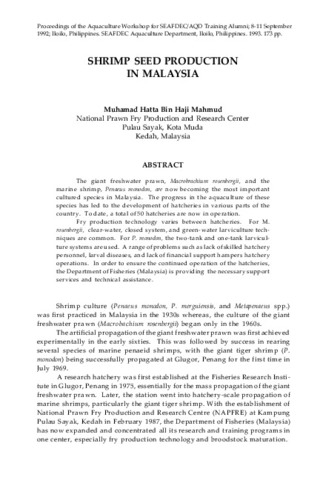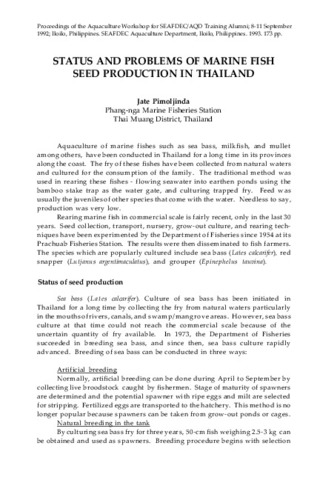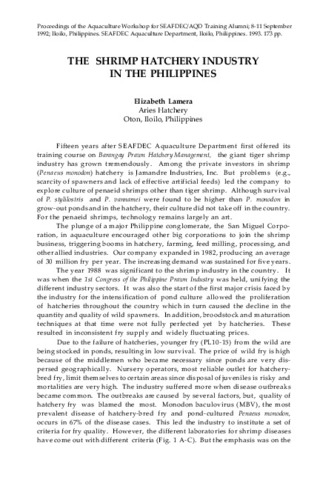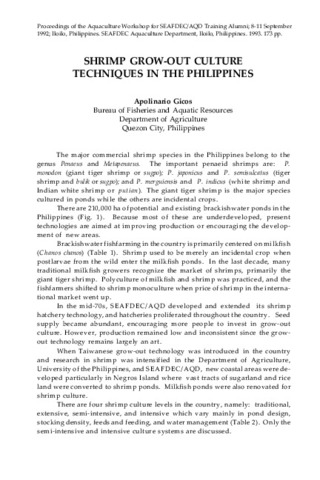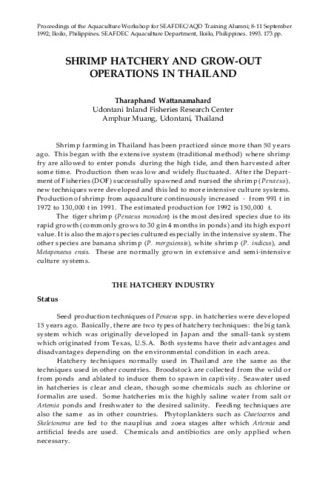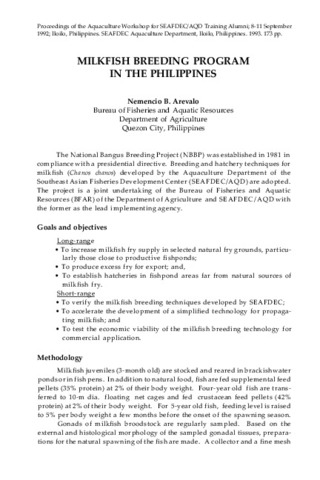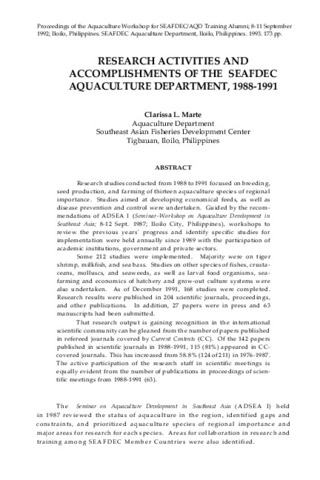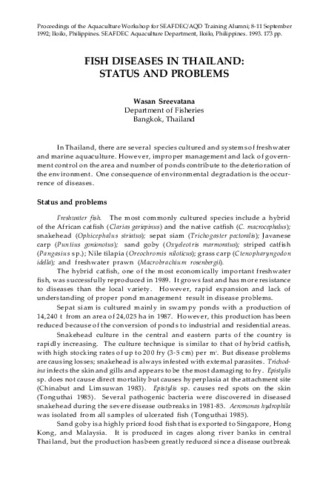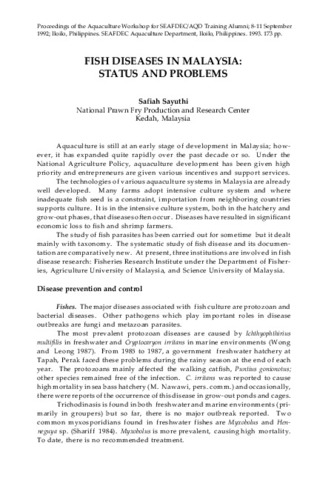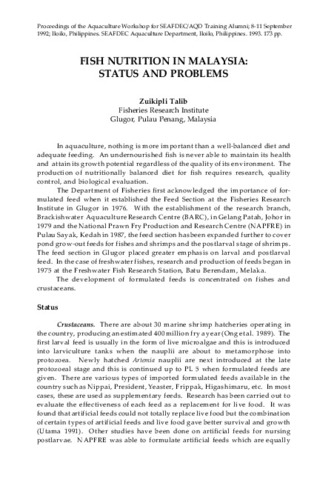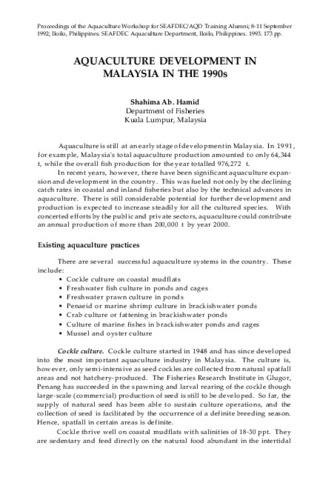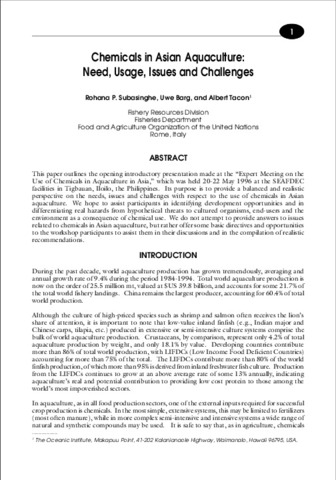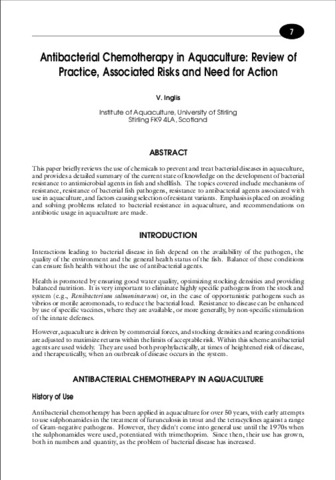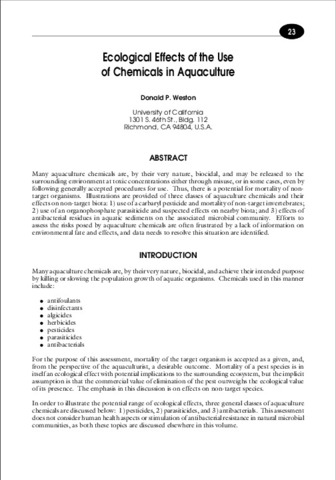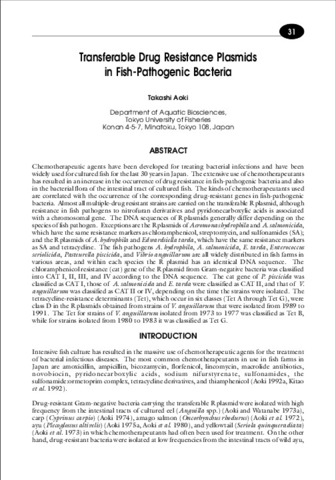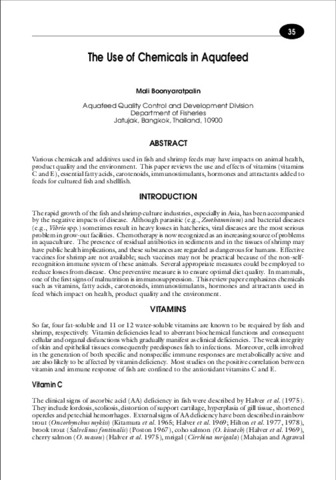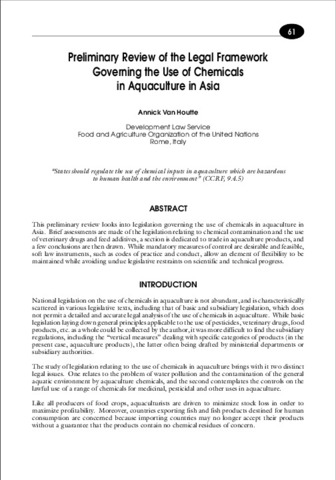Conference Proceedings: Recent submissions
Now showing items 541-560 of 767
-
Shrimp seed production in Malaysia
(Aquaculture Department, Southeast Asian Fisheries Development Center, 1993)The giant freshwater prawn, Macrobrachium rosenbergii, and the marine shrimp, Penaeus monodon, are now becoming the most important cultured species in Malaysia. The progress in the aquaculture of these species has led to ... -
Status and problems of marine fish seed production in Thailand
(Aquaculture Department, Southeast Asian Fisheries Development Center, 1993)Aquaculture of marine fishes such as sea bass, milkfish, and mullet among others, have been conducted in Thailand for a long time in its provinces along the coast. The fry of these fishes have been collected from natural ... -
The shrimp hatchery industry in the Philippines
(Aquaculture Department, Southeast Asian Fisheries Development Center, 1993)Fifteen years after SEAFDEC Aquaculture Department first offered its training course on Barangay Prawn Hatchery Management, the giant tiger shrimp industry has grown tremendously. Among the private investors in shrimp ... -
Shrimp grow-out culture techniques in the Philippines
(Aquaculture Department, Southeast Asian Fisheries Development Center, 1993)The major commercial shrimp species in the Philippines belong to the genus Penaeus and Metapenaeus. The important penaeid shrimps are: P. monodon (giant tiger shrimp or sugpo); P. japonicus and P. semisulcatus (tiger shrimp ... -
Shrimp hatchery and grow-out operations in Thailand
(Aquaculture Department, Southeast Asian Fisheries Development Center, 1993)Shrimp farming in Thailand has been practiced since more than 50 years ago. This began with the extensive system (traditional method) where shrimp fry are allowed to enter ponds during the high tide, and then harvested ... -
Seed production of marine fish in Malaysia
(Aquaculture Department, Southeast Asian Fisheries Development Center, 1993)Aquaculture especially brackishwater fish culture in Malaysia has a very high potential for development. It is also a very important source of protein. The three major species cultured in cages are sea bass, grouper, and ... -
Milkfish breeding program in the Philippines
(Aquaculture Department, Southeast Asian Fisheries Development Center, 1993)The National Bangus Breeding Project (NBBP) was established in 1981 in compliance with a presidential directive. Breeding and hatchery techniques for milkfish (Chanos chanos) developed by the Aquaculture Department of the ... -
Research activities and accomplishments of the SEAFDEC Aquaculture Department, 1988-1991
(Aquaculture Department, Southeast Asian Fisheries Development Center, 1993)Research studies conducted from 1988 to 1991 focused on breeding, seed production, and farming of thirteen aquaculture species of regional importance. Studies aimed at developing economical feeds, as well as disease ... -
Fish diseases in Thailand: Status and problems
(Aquaculture Department, Southeast Asian Fisheries Development Center, 1993)In Thailand, there are several species cultured and systems of freshwater and marine aquaculture. However, improper management and lack of government control on the area and number of ponds contribute to the deterioration ... -
Fish diseases in Malaysia: Status and problems
(Aquaculture Department, Southeast Asian Fisheries Development Center, 1993)Aquaculture is still at an early stage of development in Malaysia; however, it has expanded quite rapidly over the past decade or so. Under the National Agriculture Policy, aquaculture development has been given high ... -
Fish nutrition in Malaysia: Status and problems
(Aquaculture Department, Southeast Asian Fisheries Development Center, 1993)In aquaculture, nothing is more important than a well-balanced diet and adequate feeding. An undernourished fish is never able to maintain its health and attain its growth potential regardless of the quality of its ... -
Fish nutrition in Thailand: Status and constraints
(Aquaculture Department, Southeast Asian Fisheries Development Center, 1993)Aquaculture prior to World War II was limited because marine and freshwater fish catches were still abundant. But shortage of fuel and other necessities led to an increase in food prices including fish. The demand for ... -
Aquaculture development in Malaysia in the 1990s
(Aquaculture Department, Southeast Asian Fisheries Development Center, 1993)Aquaculture is still at an early stage of development in Malaysia. In 1991, for example, Malaysia's total aquaculture production amounted to only 64,344t, while the overall fish production for the year totalled 976,272 ... -
Chemicals in Asian aquaculture: need, usage, issues and challenges
(Aquaculture Department, Southeast Asian Fisheries Development Center, 2000)This paper outlines the opening introductory presentation made at the “Expert Meeting on the Use of Chemicals in Aquaculture in Asia,” which was held 20-22 May 1996 at the SEAFDEC facilities in Tigbauan, Iloilo, the ... -
Antibacterial chemotherapy in aquaculture: review of practice, associated risks and need for action
(Aquaculture Department, Southeast Asian Fisheries Development Center, 2000)This paper briefly reviews the use of chemicals to prevent and treat bacterial diseases in aquaculture, and provides a detailed summary of the current state of knowledge on the development of bacterial resistance to ... -
Ecological effects of the use of chemicals in aquaculture
(Aquaculture Department, Southeast Asian Fisheries Development Center, 2000)Many aquaculture chemicals are, by their very nature, biocidal, and may be released to the surrounding environment at toxic concentrations either through misuse, or in some cases, even by following generally accepted ... -
Transferable drug resistance plasmids in fish-pathogenic bacteria
(Aquaculture Department, Southeast Asian Fisheries Development Center, 2000)Chemotherapeutic agents have been developed for treating bacterial infections and have been widely used for cultured fish for the last 30 years in Japan. The extensive use of chemotherapeutants has resulted in an increase ... -
The use of chemicals in aquafeed
(Aquaculture Department, Southeast Asian Fisheries Development Center, 2000)Various chemicals and additives used in fish and shrimp feeds may have impacts on animal health, product quality and the environment. This paper reviews the use and effects of vitamins (vitamins C and E), essential fatty ... -
Human health aspects of the use of chemicals in aquaculture, with special emphasis on food safety and regulations
(Aquaculture Department, Southeast Asian Fisheries Development Center, 2000)Safe and wholesome food is essential for good health. Therefore, when one considers health issues related to unsafe foods, recorded morbidity and mortality as well as economic losses in a population must be included. Due ... -
Preliminary review of the legal framework governing the use of chemicals in aquaculture in Asia
(Aquaculture Department, Southeast Asian Fisheries Development Center, 2000)This preliminary review looks into legislation governing the use of chemicals in aquaculture in Asia. Brief assessments are made of the legislation relating to chemical contamination and the use of veterinary drugs and ...

